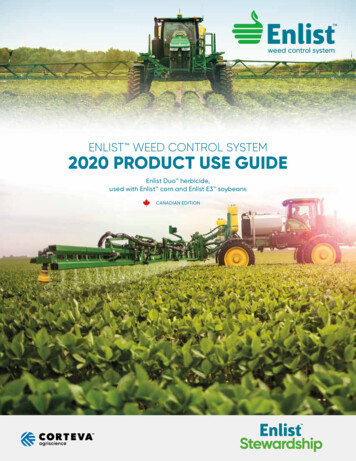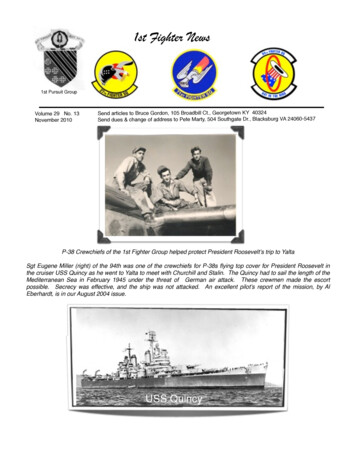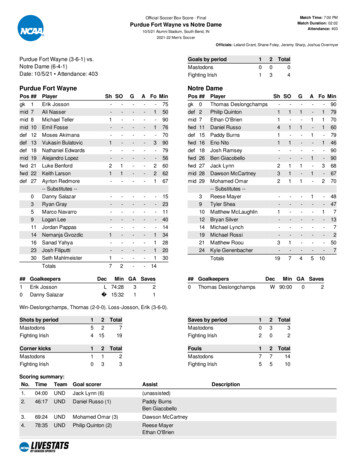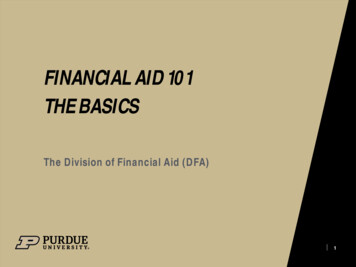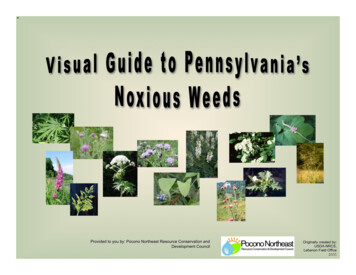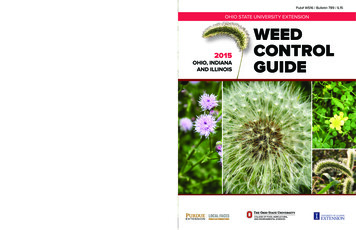
Transcription
Pub# WS16 / Bulletin 789 / IL15OHIO STATE UNIVERSITY EXTENSIONTablesTable 1.Table 2.Table 3.Table 4.Table 5.Table 6.Table 7.Table 8.Table 9.Table 10.Table 11.Table 12.Table 13.Table 14.Table 15.Table 16.Table 17.Table 18.Table 19.Table 20.Table 21.Table 22.Table 23.Table 24.Table 25.Weed Response to “Burndown” Herbicides.19Application Intervals for Early Preplant Herbicides. 20Weed Response to Preplant/Preemergence Herbicides in Corn—Grasses.30Weed Response to Preplant/Preemergence Herbicides in Corn—Broadleaf Weeds.31Weed Response to Postemergence Herbicides in Corn—Grasses.32Weed Response to Postemergence Herbicides in Corn—Broadleaf Weeds.33Grazing and Forage (Silage, Hay, etc.) Intervals for Herbicide-Treated Corn. 66Rainfast Intervals, Spray Additives, and Maximum Crop Size for Postemergence CornHerbicides.68Herbicides Labeled for Use on Field Corn, Seed Corn, Popcorn, and Sweet Corn. 69Herbicide and Soil Insecticide Use Precautions.71Weed Response to Herbicides in Popcorn and Sweet Corn—Grasses.73Weed Response to Herbicides in Popcorn and Sweet Corn—Broadleaf Weeds.74Weed Response to Preplant/Preemergence Herbicides in Soybeans—Grasses.93Weed Response to Preplant/Preemergence Herbicides in Soybeans—Broadleaf Weeds.94Grasses and Nutsedge—Response to Postemergence Herbicides in Soybeans. 95Broadleaf Weeds—Response to Postemergence Herbicides in Soybeans. 96Rainfast Intervals and Spray Additive Recommendations for Postemergence SoybeanHerbicides. 128Harvest and Feeding Intervals for Soybean Herbicides.129Weed Response to Postemergence Herbicides in Small Grains. 131Weed Response to Herbicides in Alfalfa. 146Weed Response to Herbicides in Grass Pastures/CRP/Grass Hay. 164Corn and Soybean Herbicide Premix Information. 181Restrictions on Crop Rotation. 184Glossary of Glyphosate Products, Including Formulations, SurfactantRecommendations, and Manufacturers. 186Glossary of Chemical Names and Manufacturers. 1872015OHIO, INDIANAAND ILLINOISWEEDCONTROLGUIDE
Indiana Poison Control CentersIndiana Poison CenterI-65 at 21st StreetP.O. box 1367Indianapolis, IN 46206-1367(800) 382-9097Additional copies of this publication can be ordered atestore.osu-extension.orgor by calling614-292-1607Ohio residents may also order through their county Extension office.Environmental Emergencies (chemical spills)Indiana Department of Environmental ManagementIndiana Government Center North100 North Center DriveP.O. Box 6015Indianapolis, IN 46206-601524 hours: (317) 233-7745 (emergencies only)Nonemergencies: 800-451-6027Chem Trek (800) 424-9300Indiana Pesticide Regulatory Official(including information on Worker Protection Standard WPS)Office of the Indiana State ChemistDept. of BiochemistryPurdue UniversityWest Lafayette, IN 47907(765) 494-1492or for WPS information (765) 494-1589DisclaimerThe information and suggestions in this publication are intended to provide guidelines for weed management in Ohio in thecurrent calendar year only. Because of changing laws and regulations, Ohio State University Extension assumes no liability forthe recommendations. The recommendations for using pesticides included in this guide are incomplete and should not serveas a substitute for pesticide labels. Complete instructions for the use of a specific pesticide are on the pesticide label. Thepesticide user is responsible for applying pesticides according to label directions, as well as for problems that may arise throughmisapplication or misuse of the pesticide. Label changes, product cancellations, and changes in recommendations may haveoccurred since the publication of this guide. Check with your county Extension agent in agriculture if you are in doubt about apesticide you plan to use. Trade names have been used in this guide for clarity, but do not constitute an endorsement by TheOhio State University, nor do they imply discrimination against other products.Copyright 2015, The Ohio State UniversityOhio State University Extension embraces human diversity and is committed to ensuring that all research and related educationalprograms are available to clientele on a nondiscriminatory basis without regard to age, ancestry, color, disability, gender identity orexpression, genetic information, HIV/AIDS status, military status, national origin, race, religion, sex, sexual orientation, or veteranstatus. This statement is in accordance with United States Civil Rights Laws and the USDA.Keith L. Smith, Associate Vice President for Agricultural Administration; Associate Dean, College of Food, Agricultural, andEnvironmental Sciences; Director, Ohio State University Extension; and Gist Chair in Extension Education and Leadership.For Deaf and Hard of Hearing, please contact Ohio State University Extension using your preferred communication (e-mail, relayservices, or video relay services). Phone 1-800-750-0750 between 8 a.m. and 5 p.m. EST Monday through Friday. Inform theoperator to dial 614-292-6181.12/14—4.2M—A&BIllinois Poison Control InformationNational Poison Control Center1-800-222-1222This number will automatically connect you to the center closest to you.Spill Assistance: For major spills, Illinois law requires that emergencynotification be made to the Illinois Emergency Management Agency (IEMA).They in turn notify the appropriate agencies for response. Their 24-houremergency hotline number is:Illinois Emergency Management Agency1-800-782-7860
Weed Control Guide forOhio, Indiana and IllinoisMark M. Loux, Doug Doohan and Anthony F. DobbelsDepartment of Horticulture and Crop ScienceThe Ohio State UniversityWilliam G. Johnson, Bryan G. Young and Travis R. LegleiterDepartment of Botany and Plant PathologyPurdue UniversityAaron HagerDepartment of Crop SciencesUniversity of Illinois
ContentsWeed Control Principles .1Burndown Herbicide Programs for Corn and Soybeans . 16Burndown Herbicides in No-Tillage Corn and Soybeans .21CornCorn Herbicide Management Strategies .28Preplant or Preemergence. 34Postemergence. 47Postemergence—LibertyLink Corn.61Postemergence—Glyphosate-Resistant Corn.62Harvest Aid.65Popcorn and Sweet Corn Weed Management. 72Preplant or Preemergence. 75Postemergence.81Popcorn Harvest Aid.89Postemergence—Attribute Bt11 (glufosinate-resistant) Sweet Corn.89Postemergence—Glyphosate-Resistant Sweet Corn.90SoybeansSoybean Herbicide Management Strategies .91Preplant or Preemergence. 97Postemergence.111Postemergence—LibertyLink Soybeans.123Postemergence—Roundup Ready Soybeans.124Harvest Aid. 126Small GrainsWeed Management Strategies for Wheat . 130Wheat Only.132Oats and Wheat. 136Oats and Wheat—Underseeded with Legumes.141Wheat: Harvest Aid.142Figure 1. Wheat Growth Stages and Herbicide Application.143ForagesManaging Weeds in Legumes .144Forage Legumes.147Alfalfa: Preharvest Glyphosate Application. 152Mixed Grass-Legume Forages: Established Stands Only.153Management Strategies for Permanent Grass Pastures/CRP/Grass Hay . 155Control of Problem Weeds . 166Control of Marestail in No-till Soybeans . 193Palmer Amaranth Biology, Identification, and Management . 197Poison Information Centers . 210Table Listing on Back Cover
1Weed Control PrinciplesImportance of Weed ControlWeed control is an essential part of all crop production systems. Weeds reduce yields by competing withcrops for water, nutrients, and sunlight, and may directlyreduce profits by hindering harvest operations, loweringcrop quality, and producing chemicals which are harmful to crop plants (allelopathy). Left uncontrolled, weedsmay harbor insects and diseases and produce seedor rootstocks which infest the field and affect futurecrops. Despite large expenditures for weed control, itis estimated that losses in U.S. crops due to weeds leftuncontrolled exceed 8 billion annually.Years of research have shown that good weed control within the first 4 to 6 weeks after crops are planted is critical in order to avoid a yield reduction fromweeds. The ef fectiveness of any weed control programdepends largely upon one factor - timeliness. There aremany cultural, mechanical, and chemical methods ofweed control that are effective if applied at the correcttime. Fields that are kept free of weeds for the first fourto six weeks after planting give the crop a “head start”which enables it to shade out or otherwise out competeweeds that emerge later in the season.Identify specific weed problems. Weed speciesvary greatly in their ability to compete with crops andreduce yields. Is 100% control of all weeds necessary?Perhaps this can be answered by stating that most successful producers design control programs to maximizeprofit, not just to control weeds. While it is true thatcrops are able to tolerate a certain threshold numberof weeds without suffering a yield reduction, there aresome weeds for which 100% control may be desirablebecause they are particularly competitive, persistent, ordifficult to control.Cultural And Mechanical (Nonchemical) Weed ControlHerbicide performance is strongly related to environmental conditions, so not even the best herbicides areequally ef fective from year to year. The most desirableweed control program is one that will economically control existing weeds and prevent a buildup of weed seedor tubers, rhizomes, etc. in the soil. Such a weed controlprogram includes integrating several crop managementpractices in addition to use of herbicides.Crop rotation is one of the most effective culturalpractices for improving long-term weed control. Croprotation aids in controlling weeds by: (1) allowing rotationof herbicides as well as crops, and (2) providing the opportunity to plant highly competitive crops that preventweed establishment. Many herbicides available for usein corn are extremely effective at controlling weeds forwhich there are no adequate controls in soybeans orother crops. Rotation to a densely planted crop such asalfalfa or small grains helps control annual weeds withlittle, if any, chemical input. Rotating to small seededlegumes (e.g. alfalfa) or other densely grown perennialgrass-legume forage mixtures is ef fective at reducingpopulations of some perennial weeds.Any practice that promotes optimum early andvigorous crop growth helps give crops a competitiveedge over weeds. The following are some of thesepractices: Narrow row spacings (15 inches or less) for soybeans Proper planting date and seeding rate Use of insect-,disease-, and nematode-resistantvarieties Insect and disease control Adequate soil fertility Adequate drainageThe following are several other preventative culturalpractices that help prevent weeds from becoming established and spreading: Control weeds in noncropland areas, includingfencerows, drainage ditch banks, and rights-of-way Plant only high quality weed-free crop seed Do not spread manure, hay, or crop residues contaminated with weed seed on cropland Clean farm machinery between fields to avoid transport of weed seed, rhizomes, tubers, and rootstocks If “new” or unfamiliar weeds appear, have them identified quickly and take appropriate control measuresMechanical weed control is still an important component of many weed control programs. Primary tillageinvolves moldboard plowing or some type of reducedtillage that destroys existing vegetation and allowsadequate seedbed preparations. Secondary tillage isperformed with a tandem disk, field cultivator, or similarimplement for final seedbed preparation. Selective cultivation is performed with a rotary hoe, rolling cultivator,shovel (sweep) cultivator, or similar implement to controlweeds after the crop has emerged from the soil.If selective cultivation is used, it should be doneearly. Rotary hoes operated at a relatively high speed (7to 10 mph) on fairly dry soil are effective for controllingsmall weeds (less than 1 inch tall). For maximum ef fec-
2tiveness, a rotary hoe should be used when weeds arein the “white stage”, or just emerging from the soil. Cultivation with a shovel, sweep, or rolling cultivator is moreeffective than a rotary hoe on larger weeds, but shouldstill be operated when weeds are very small. Cultivations should be shallow (1 to 2 inches deep) to preventexcessive root damage to the crop, depletion of soilmoisture, or excessive ridging, which creates problemsat harvest for some crops.Conventional tillage systems involve primary andsecondary tillage. These operations may be followedby selective cultivation, depending on the crop and itsrow spacing. Conventional tillage is effective for reducing populations of many biennial and perennial weedsthat may may arise from rhizomes or rootstocks. Annualweeds that reproduce only from seed will most likely stillbe a problem and require additional controls.Conservation or reduced tillage systems do notinvolve moldboard plowing, and maintain some previouscrop residue on the soil surface. Tillage in a reducedtillage system consists of using a disk, field cultivator,or chisel plow and may be the last operation beforeplanting. No-till crop production involves no primary orsecondary tillage. The crop is planted directly into a sodor the previous year’s crop residue. Conservation tillagesystems generally rely more heavily on chemical weedcontrol than conventional tillage systems. For additionaldetails on reduced tillage systems, refer to other sections of this chapter.Chemical Control of WeedsWhen designing a weed control program based onherbicide use, consider soil type, tillage practices, crops(current and following), weed problems, and overallfarming operations. It is important to select herbicidesbased on the weeds known to be present in a field. Herbicides are often combined to control a broader spectrum of weed species, reduce carryover, or reduce cropinjury. Herbicide activity is affected by the weather, soilconditions, weed size, accuracy of application, and otherfactors.While research has shown that weeds will not reducecrop yields if controlled within 4 to 6 weeks after emergence, preplant and preemergence herbicides have theadvantage of eliminating weeds before they reach thisthreshold. Postemergence herbicides are comparable tosoil-applied herbicides in effectiveness and economics ifapplied within the same threshold period. Some weedsare better controlled by soil-applied herbicides, whileothers are more susceptible to postemergence herbicides. Consider using a program consisting of preemergence and postemergence herbicides for maximumweed control and protection of crop yield.Herbicide Nomenclature and FormulationsThere is often more than one formulation of a particular herbicide. This can make selection and application of various products somewhat confusing. Eachherbicide has at least one trade name, a common name,and a chemical name. For example, Lasso and Intrro areregistered trade names, alachlor is the common name,and etamide is the chemical name for a herbicide used incorn and soybeans.Prepackaged mixtures contain two or more different herbicides. For example, Bicep II Magum/Cinch ATZ(trade names for the same product) is actually a mixtureof s-metolachlor and atrazine. For this reason it is important to know common names of herbicides so that oneknows exactly what a product contains.Herbicides are sold in various liquid or solid formulations, depending upon (1) the solubility of the active ingredient in water, and (2) the manner in which the product is applied (i.e. dispersed in water or applied in thedry form). The formulation type is listed on the herbicidelabel and may be designated by a letter or letters following the trade name. A herbicide label must also give alist of all herbicideally active ingredients and the amountof active ingredient contained in the product. For liquidformulations, the amount of active ingredient is expressed both as a percentage of the total ingredientsand as the amount of active ingredients ins in a gallon ofproduct. Active ingredients contained in dry formulationsare expressed only as a percentage by weight. Severalformulations and abbreviations are listed below.Emulsifiable concentrate (E or EC) - a liquid formulation containing various emulsifiers that aid in dispersingthe active ingredient in water.Water Soluble (S, AS, or WS) - usually a liquid formulation containing the active ingredient, water, andsometimes a surfactant and an antifreeze agent.Oil Soluble (OS) - a liquid formulation containing theactive ingredient dissolved in oil or some other organicsolvent. These herbicides must be applied in an oilbased carrier such as diesel fuel or kerosene.Liquid Flowable (F or LF) - a thick liquid with a slurrylike consistency containing the active ingredient, water,and stabilizers to help the active ingredient stay in suspension. Spray tank agitation is necessary to keep theproduct from settling out of the spray solution.Suspension Concentrate (SC) - similar to Liquid Flowable.Wettable Powder (W or WP) - a dry powder containing the active ingredient, a diluent or carrier (usuallybentonite or attapulgite clay), and surfactants. Spraytank agitation is necessary to keep the product from settling out of the spray solution.
3Dry Flowable (DF) - a dry herbicide-impregnatedgranules that easily disperses in water. Dry flowables areeasier to handle and measure than wettable powders.Spray tank agitation is necessary to avoid settling.Dispersible Granules (DG) or Water-Dispersible Granules (WDG) - a dry formulation similar to dry flowableformulations. The ingredients are in granules that easilydisperse in water. Spray tank agitation is necessary toavoid settling.Granules (G) - a dry formulation consisting of the active ingredient coating or adhered to some type of inertgranule such as clay, vermiculite, or sand. These formulations are applied as a ready-to-use product. Granularapplication equipment is required.Pellets (P) - a dry formulation of active ingredient coating or adhered to some type of inert pelletedmaterial - similar to granules only much larger. Pelletsare applied directly to the target area by hand or withspreaders.Herbicide rates are sometimes expressed on an active ingredient basis in technical publications. To convertpounds of active material to pounds of a commercial dryformulation use:Pounds of commercial product/A Pounds of active ingredient/APercent Active Ingredient in ProductTo convert pounds of active material to gallons of acommercial liquid formulation use:Gallons of commercial product/A Pounds of Active Ingredient/APounds of Active Ingredient in GallonSoil-Applied HerbicidesSoil-applied herbicides can be applied preplant (orearly preplant), preplant incorporated, or preemergenceto the crop. The activity of these herbicides is affectedby soil texture, organic matter content, pH, moisture,and tillage. Soil-applied herbicides are more readilyavailable for plant uptake in coarse-textured, low organic matter soils than in fine-textured, high organic mattersoils. Selection of the appropriate herbicide rate is oftenimportant to avoid injury. Many herbicide labels specifyapplication rates based on soil texture and organic matter content. Some herbicides are not labeled for use insandy soils low in organic matter.Soil pH can influence the activity of herbicides. Triazine herbicides are more available for plant uptake insoils with high pH, resulting in better weed control butincreased risk of crop injury. The low pH resulting fromcontinuous no-tillage or lack of lime application mayreduce the availability of some herbicides, causing lesseffective weed control. In general, herbicides are mosteffective when soil pH is in the range recommended foroptimum crop growth.Soil-applied herbicides require adequate soil moisture for activity since uptake into germinating weedsoccurs from the soil solution only. In the presence ofadequate soil moisture, less herbicide is adsorbed ontothe soil and more is available in the soil solution forweed control. Under dry conditions, herbicide is tightlyadsorbed by soil colloids, and insuf ficient amounts maybe available to provide acceptable weed control. Soilapplied herbicides require rainfall (usually 1/2 inch ormore) to move them from the soil surface into the zonewhere weed seed germinate and emerge.Early preplant herbicides are applied to the soilsurface from a few weeks to more than a month priorto planting. Herbicides with a long residual soil activitycan be applied early preplant. Herbicides with a shortersoil residual activity may not provide late season controlwhen applied early. Early preplant herbicide programsfrequently do not provide adequate season-long annual grass control in fields with moderate to high grasspopulations.Advantages Allows more time for rainfall to move herbicides fromthe soil surface into the zone where weed seedsgerminate. Herbicides can be applied with fertilizer, eliminatingfield trips. Reduces workload at planting time. Prevents the emergence of annual weeds and eliminates the need for a burndown herbicide applicationat the time of planting. Allows more time for herbicide degradation in thesoil, reducing the risk of herbicide carryover problems.Disadvantages Limits herbicide options since not all herbicides havesufficient soil residual for early application. May require higher rates, split applications, or subsequent postemergence applications for later seasoncontrol. May cause soil compaction from operating application equipment when soils are wet.Preplant incorporated herbicides are mixed into thesoil prior to planting. Incorporation of some herbicides isnecessary to prevent surface-loss from volatility or photodecomposition. Other herbicides are incorporated toreduce the dependence upon rainfall to move herbicideinto the weed seed germination zone.
4Advantages Reduced dependence upon rainfall to position herbicides in the soil, providing more reliable weed controlthan preemergence applications. More effective control of yellow nutsedge than withpreemergence applications. Herbicide may be applied with fertilizer.Disadvantages Incorporation may result in added tillage and fuelcosts. Incorporation can result in soil compaction and crusting. Weed control can be reduced if the herbicide isdiluted by incorporation that is too deep. Streaking of herbicides due to improper incorporation can result in erratic weed control. Planting operations can be slowed due to the timerequired for herbicide application and incorporation.The depth and thoroughness of incorporation depend upon the type of equipment used, the depth andspeed of operation, soil texture, and the amount of soilmoisture. Incorporation should place the herbicide uniformly throughout the upper 1 to 2 inches of soil for bestcontrol of small-seeded annual weeds. Slightly deeperplacement may improve control of certain weeds fromdeep-germinating seeds, especially under dry conditions. The field cultivator and tandem disk place most ofthe herbicide at about one-half the depth of operation,so the suggested depth of operation for these implements is 3 to 4 inches.Thorough and uniform incorporation, especially witha tandem disk or field cultivator, requires two passesat an angle to each other. However, some of the newercombination tools can provide uniform single-pass incorporation. The effectiveness of single-pass incorporationdepends upon soil condition as much as the implement.One-pass incorporation is not a good approach with lessthan optimum soil tilth. Incorporation into soils that aretoo wet can result in streaked weed control; this maybe increased with one-pass as compared to two passincorporation. High crop residue levels make one-passincorporation difficult to achieve.Field cultivators are frequently used for herbicide incorporation. Two passes are recommended for uniformweed control, but field cultivators can give acceptableone-pass incorporation with proper set-up and operation. They should have 3 or more rows of shanks with aneffective shank spacing of no more than 8 to 9 inches.Shanks can be equipped with points or sweeps. Sweepsusually provide better incorporation, especially whensoil conditions are too wet or dry for optimum soil flowand mixing. Sweeps for “C” shank cultivators should beat least as wide as the effective shank spacing. For onepass incorporation, wider sweeps or narrower spacingwith a 3- to 5- bar harrow or rolling baskets will improveuniformity of incorporation and weed control.The recommended operating depth for the fieldcultivator is 3 to 4 inches with a ground speed of at least6 miles per hour. The field cultivator must be operatedin a level position. If the back shanks are lower than thefront, untreated soil will be brought to the surface resulting in streaked weed control.Tandem disk harrows invert the soil and usuallyplace the herbicide deeper in the soil than most otherincorporation tools. Tandem disks used for herbicideincorporation should have disk blade diameters of 20inches or less and a blade spacing of 7 to 9 inches.Spherical disk blades provide better herbicide mixing than conical disk blades. The tandem di
Any practice that promotes optimum early and vigorous crop growth helps give crops a competitive edge over weeds. The following are some of these practices: Narrow row spacings (15 inches or less) for soybeans Proper planting date and seeding rate Use of insect-,disease-, and nematode-resistant varieties Insect and disease control

